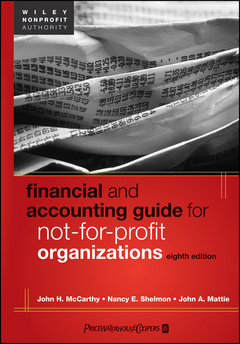Description
Financial and accounting guide for not-for-profit organizations (series: wiley nonprofit authority) (hardback) (8th Ed.)
Wiley Nonprofit Authority Series, Vol. 6
Authors: McCarthy John H., Shelmon Nancy E., Mattie John A.
Language: English
Subject for Financial and accounting guide for not-for-profit...:
Keywords
Malvern Gross, John McCarthy, Nancy Shelmon, financial and accounting guide for nonprofits, AICPA accounting and audit guide, PricewaterhouseCoopers, financial management for public health and not for profit organizations, steven finkler, effective financial management in public and nonprofit agencies, jerome mckinney, financial management for nonprofit human service organizations, raymond sanchez mayers
Approximative price 319.69 €
In Print (Delivery period: 12 days).
Add to cart896 p. · 17x25.7 cm · Hardback
Description
/li>Contents
/li>Biography
/li>
Completely revised and expanded edition of the nonprofit industry"s bestselling finance and accounting standard
The accounting environment has changed dramatically over the past ten years, especially in the nonprofit sector. Filled with authoritative advice on the financial reporting, accounting, and control situations unique to not-for-profit organizations, this new updated Eighth Edition of Financial and Accounting Guide for Not-for-Profit Organizations addresses the many changes that have recently affected the finance and accounting practices of the nonprofit sector, with a focus on fair value accounting.
Representing the collaborative efforts of many expert PricewaterhouseCoopers professionals, Financial and Accounting Guide for Not-for-Profit Organizations presents the accounting and reporting guidelines for different types of nonprofits, complete guidance on tax and compliance reporting requirements, illustrated explanations of various acceptable financial statements, a how-to section on setting up and keeping the books with step-by-step procedures and forms, and commentary on computers and accounting software.
Highlighting organizations that have fully integrated "net asset" accounting into their financial reporting, this completely revised and streamlined Eighth Edition has been updated to include:
The latest updates on regulatory reporting and disclosure changes
The introduction of fair value accounting, which affects the ways in which investments, contributions receivable, and split interest agreements are viewed and valued
Completely revamped and revised AICPA accounting and audit guidelines for nonprofit organizations
Many new topics, including microfinance and expanded disclosure on gifts-in-kind accounting, valuation, and reporting
A new chapter on the municipal bond market
FASB Codification and how to find accounting literature
A new appendix addressing the convergence of IFRS with U.S. GAAP
Long recognized as the industry-standard reference on not-for-profit finance and accounting, Financial and Accounting Guide for Not-for-Profit Organizations is a must-have for nonprofit accountants and financial managers, nonprofit executives and directors, boards of directors/trustees, and CPAs for nonprofit organizations.
As a celebratory bonus, when you purchase this print version, you will also receive a free e-book download of Financial and Accounting Guide for Not-for-Profit Organizations, Eighth Edition. For details, see the inside back cover of this book.
Contributors xix
Preface xxi
INTRODUCTION Including the FASB Codification 1
CHAPTER 1 Responsibilities for Fiscal Management 5
1.1 Keeping Financial Records for the Organization 6
1.2 Preparing Accurate and Meaningful Financial Statements 6
1.3 Implementing a Budget and Anticipating Financial Problems 7
1.4 Safeguarding Financial Assets and Providing Effective Internal Controls 8
1.5 Complying with Federal and State Reporting and Regulatory Requirements 9
1.6 Communicating Fiscal Information to the Board of Directors and the Audit Committee 9
1.7 Ten Key Points to Consider in Not-for-Profit Fiscal Management 10
1.8 Conclusion 14
PART I KEY FINANCIAL CONCEPTS 15
CHAPTER 2 Accounting Distinctions between Not-for-Profit and Commercial Organizations 17
2.1 Stewardship versus Profitability 17
2.2 Principal Areas of Accounting Differences 18
2.3 Conclusion 22
CHAPTER 3 Cash- versus Accrual-Basis Accounting 23
3.1 Cash and Accrual Statements Illustrated 23
3.2 Combination Cash Accounting and Accrual Statements 27
3.3 Modified Cash Basis 29
3.4 Legal Requirements 30
3.5 Conclusion 30
CHAPTER 4 Fund Accounting and Internal Financial Reporting 31
4.1 Fund Accounting Defined 33
4.2 Categories of Funds 34
4.3 Alternative Fund Groupings 37
4.4 Typical ''Fund'' Financial Statements 38
4.5 Transfers between Funds 40
4.6 Elimination of Funds for Reporting Purposes 41
4.7 Conclusion 43
CHAPTER 5 Fixed Assets and Depreciation 45
5.1 General Principles-Working Definitions 45
5.2 Property and Equipment-Classes and Kinds of Assets 47
5.3 Fixed Assets Where Title May Revert to Grantors 49
5.4 Collections 50
5.5 Fair Value Measurement 51
5.6 Contributions Restricted for Purchase of Fixed Assets 51
5.7 Impairment or Disposal of Long-Lived Assets 52
5.8 Conclusion and Recommendations 55
CHAPTER 6 Investment Income, Gains and Losses, and Endowment Funds 57
6.1 Accounting Principles 58
6.2 Total Return Concept 68
CHAPTER 7 Affiliated Organizations, Pass-Through Transactions, and Mergers 73
7.1 Types of Relationships Often Found 74
7.2 Definition of the Reporting Entity 76
7.3 Mergers of Not-for-Profit Organizations 81
Appendix 7-A Factors to Be Considered in Deciding Whether a Pass-Through Gift Is Truly Revenue and Expense to a Pass-Through Entity 84
Appendix 7-B Transfers of Assets to a Not-for-Profit Organization or Charitable Trust That Raises or Holds Contributions of Others 87
Appendix 7-C Factors Related to Control That May Indicate That an Affiliated Organization (A) Should Be Combined with the Reporting Organization (R), If Other Criteria for Combination Are Met 91
CHAPTER 8 Contributions, Pledges, and Noncash Contributions 93
8.1 Expendable Current Support 94
8.2 Gifts-in-Kind 99
8.3 Support Not Currently Expendable 103
Appendix 8-A: Checklist: Factors to Be Considered in Deciding Whether a Particular Gift (for Operating Purposes) Should Be Classified as Purpose-Restricted or Not 114
Appendix...
NANCY E. SHELMON retired as a senior partner from PricewaterhouseCoopers in 2010 after more than thirty years working with not-for-profit and higher education clients. A frequent speaker at AICPA and state society conferences, she also served as a member of the AICPA's Not-for-Profit Expert Panel for eleven years and has worked with some of the most widely respected not-for-profit organizations in North America.
JOHN A. MATTIE serves as PricewaterhouseCoopers' National Education and Nonprofit Practice Leader. He currently serves on the Financial Accounting Standards Board Not-for-Profit Advisory Committee, and is the firm's representative on the AICPA Not-for-Profit Entities Expert Panel and the AICPA Government Audit Quality Control Center.




